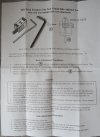Solarfire
Experienced
If your action gets higher under string-tension the truss-rod needs readjustment, makes no sense to shim the neck to do what the truss-rod is for. Evaluation of truss-rod adjustment is done under string-tension. Shimming is only necessary when the truss-rod is loose and the neck has a slight convex curvature under string-tension.
String up and tune to pitch, check the relief under tension with a straightedge that covers the entire range of the fretboard (or fret the high E @ first and last fret). @ about the 12th fret (+/- 2) the relief (gap of string to fret) should be adjusted to about 0-0.4mm as a starting point. Don’t adjust the truss-rod under string-tension!!
Play the guitar and check for possible fret-buzz, if no buzz, decrease relief to taste, else, increase until fret-buzz is eliminated.
Getting the action correct is a combination of truss-rod and bridge-height adjustment.
String up and tune to pitch, check the relief under tension with a straightedge that covers the entire range of the fretboard (or fret the high E @ first and last fret). @ about the 12th fret (+/- 2) the relief (gap of string to fret) should be adjusted to about 0-0.4mm as a starting point. Don’t adjust the truss-rod under string-tension!!
Play the guitar and check for possible fret-buzz, if no buzz, decrease relief to taste, else, increase until fret-buzz is eliminated.
Getting the action correct is a combination of truss-rod and bridge-height adjustment.
Last edited:


